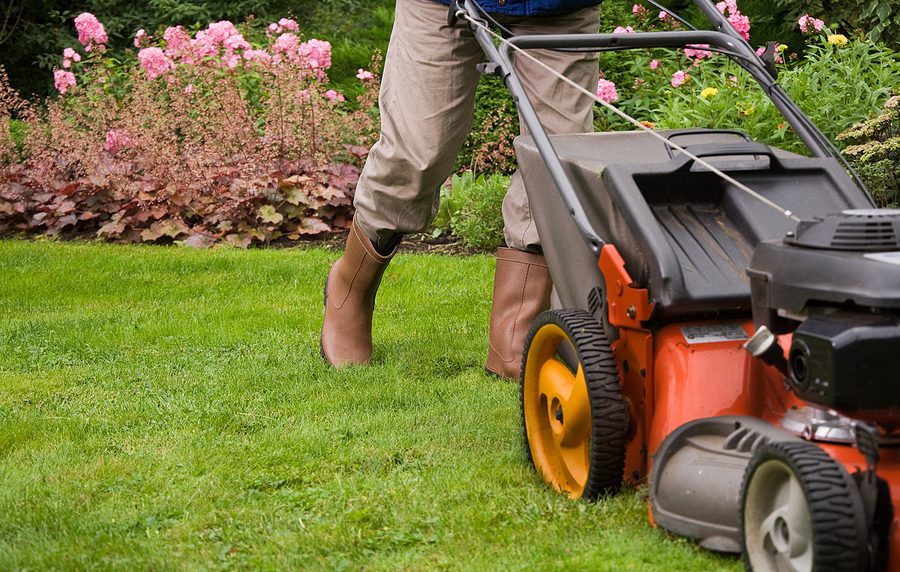What are Some Great Lawn Care Tips that Can Help Me Improve My Lawn?

As spring turns into summer, you start transitioning into lawn care and maintenance of your yard. That’s because it has to be maintained regularly to make sure it looks beautiful and inviting as the days begin to warm.
This guide is full of the useful basics: when to rake, water, and feed, to keep your lawn healthy and your grass looking great.
Rake or De-Thatch Your Lawn
Do not walk or work on your lawn until it has thawed out in spring to avoid killing the blades.
Rake your yard well, to free matted grass clumps and reduce thatch before your inaugural mow of the year. Thatch is a layer of leaves, roots and dead grass blades that accumulate between the live grass and the soil, and that can prevent water and air from reaching the grass.
The first rakes of the season will be done with spring tine rakes.
Avoid raking when the soil is soft because you will be more likely to pull up the healthy grass crowns.
Aerate the Soil
One other way to soften thatch and the symptoms of compacted soil is with a core aerator that removes plugs of soil and allows more air, water, and nutrients to reach the roots.
- Aerate cools season grass in spring or fall.
- Aerate cool season grasses in the fall to late fall.
- Aerate clay soils, or the most trod upon part of your lawn, once a year.
- An active lawn will require core aeration every two or three years.
Fertilize the Grass
Fertilize in the spring: Once the grass begins to green up, fertilize with a spring fertilizer about three weeks after it starts greening up or after the first two or three mowings. Apply too soon and you run the risk of weeds feeding or fertilizer runoff.
If you are putting down fertilizer, water your lawn a few day ahead to avoid burning the roots. Pick the right lawn fertilizer from among these options based on grass type, climate and any growth issues, and read the package instructions to make sure you don’t over-fertilize.
If you experience problems with crabgrass, apply a crabgrass preventer fertilizer in early spring. Check the packaging of your product to find out how soon after applying the crabgrass preventer you can use a weed killer.
If you’ve got common or broadleaf weeds, apply a weed and feed product when daytime temperatures are between 60 and 90 degrees Fahrenheit.
Give the lawn a good drink first so it is damp. But if rain is expected in two days, it’s not worth applying as the rain will wash it away.
When your grass grows thick and healthy, it should crowd out most weeds. The roots of the grass should remain in the shade, as well, and be better able to tolerate summer heat.
Cable spreader Make sure you spread your granular fertilizer at the correct rate with even coverage over your grass. To find out what settings you should use, read the instructions on the back of your spreader.
Back and forth in straight lines will be your walking pattern each pass when you apply the fertilizer.
Follow the instructions on the product regarding how much fertilizer to apply and when to apply more.
Apply Seed and Lime to the Lawn
Overseed bare patches in your lawn or areas where growth is thin. Think of seeding after you apply a slowrelease nitrogen fertilizer. Reseeding is best done in early spring and fall.
- Test your yard’s pH this spring to find out how acidic your soil is. The preferred pH for most grasses is 5.8 to 7.2. When soil is too acidic, you may notice an increase in moss, weeds, diseases and insect pests.
- If you want to know your soil’s pH, use a pH soil test kit or ask a county extension agent to test your lawn for a fee.
- In much of the nation, a lime application can make the soil less acidic, helping the grass to take in fertilizers and the nutrients in the soil.
- Soil pH naturally varies and changes with time, so it may be necessary to retest annually until readings are level. Established lawns, however, can be tested every 3 years or so.
- The best time to add lime to a lawn that requires it is in spring and fall. Consult your soil test results to find out how much lime to add, then follow the instructions on the lime’s packaging.
- Tip: Spring-planted lawns often require more watering, weeding and other attention during the summer. Fall seeding is less fussy.
Water the Lawn
In some areas there is a spring runoff. As a general rule, grass requires an inch of water a week, whether it comes from rain or as part of a spring lawn care regimen using a garden hose, sprinkler or irrigation system.
- Water during the cooler parts of the day, before 10 a.m. in late spring into summer, to minimize evaporation in the warmed air.
- When watering the lawn, deep watering is key to creating long and deep roots.
- To check whether your lawn needs water, do this test: Step on and then off your grass, and see how fast the blades spring back. And if the blades are slow to bounce back, or wilted, curled or dull in color, it might be time to water.
Mowing and Lawn Care Tips
Put your lawn mower in the prepared state in spring, conduct an inspection and perform necessary maintenance, such as the oil or spark plugs, prior to mowing. It’s also essential that your lawn mower blade is sharp, to ensure a clean cut. Stay safe, and always take out the spark plugs before working on your lawn mower.
- Begin mowing as soon as the ground is dry and your grass is long enough to require cutting. Don’t mow too low: Clipping the grass too short allows sunlight to penetrate the soil, promoting the growth of weed seeds.
- Try to keep the mowing height set high enough so it removes no more than the upper one-third of the height of the grass blades. The taller the grass blades, the deeper the roots and the healthier the lawn, but it may mean you have to mow more often.
- Consult your mower’s manual to see if it has a recommended setting for your style of grass.
- Mow the lawn: Apparently, grass with dew or fog on it and 80-plus degree temperatures can cause grass clippings to clump and damage your lawn. Do not mow when it’s raining, or just after a rain, as the mower won’t cut the grass evenly and likely will clog up with clumps of wet grass blades.
- Change up the pattern every time you mow. This prevents there from being ruts as well as keeps the grass from constantly being bent one way.
- You should mow when your grass needs to be mowed, not on a schedule. Grass grows at a faster rate in the spring and early summer than at season’s end.
Tip: Empty the tank of gas before storage at the end of the mowing season, to ensure the next cutting season starts with a fresh tank.
Dispose of Lawn Clippings
You can allow grass clippings to remain on your lawn as long as they don’t start to develop a thick thatch layer. Then, take the clippings away and dethatch your lawn if necessary. Fill a lawn and leaf bag with clippings by raking them.
Tip: If you chemically treat your lawn, don’t compost the clippings.
Final Thoughts
Great DIY spring lawn care can help reduce your workload in your yard later this year. Follow these lawn care tips to ensure your grass is greener.
When figuring out how much grass seed or mulch you require, fudge is not the number to use, figure. Determine an amount that you need with our project calculators.
